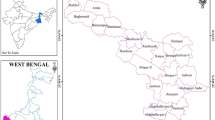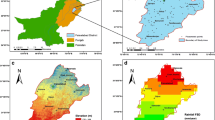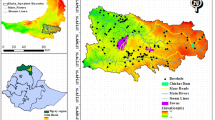Abstract
In the recent years, the vulnerability of groundwater aquifers to pollution is one of the major issues. The fast growth of industrialization, deforestation and agricultural activities are the potential sources for groundwater pollution. Assessment of groundwater vulnerability in a region is necessary for any groundwater management and developmental activities. The present study assess the aquifer vulnerability to contamination along a limited stretch of Cauvery River (Kumarapalayam to Kokkarayanpettai) in Namakkal and Erode district, in the state of Tamil Nadu, India, using modified DRASTIC model. The textile dyeing units and other small-scale industries are located along Kumarapalayam to Kokkarayanpettai stretch on the bank of the Cauvery River. The river course is highly polluted due to disposal of effluent from a number of dyeing industries. In the first step, the ranks and weights were assigned for the DRASTIC parameters including groundwater depth (D), net recharge (R), aquifer media (A), soil media (S), topography (T), impact of vadose zone (I) and hydraulic conductivity (C). These parameters were integrated and reclassified into five categories such as very low (1.88%), low (9.33%), moderate (24.23%), high (52.57%) and very high (11.99%) vulnerability zones. The results revealed that about 64% of the study area was affected by groundwater vulnerability as per DRASTIC index. Further, the lineament density and land use/land cover were incorporated in the DRASTIC model. The integrated results also show the major groundwater aquifer zone in the study area vulnerable to pollution. Finally, the modified DRASTIC model was validated with nitrate (NO3) concentration in the groundwater samples and it shows 82.42% accuracy in the result. It confirms that the modified DRASTIC model is one of the essential tools to estimate the groundwater pollution risk. The overall results revealed that the groundwater aquifer in the study area is facing contamination due to sewage disposal and dyeing industry. Immediate attention is required for maintaining groundwater aquifer free from contaminations.














Similar content being viewed by others
References
Al-Adamat RAN, Foster IDL, Baban SMJ (2003) Groundwater vulnerability and risk mapping for the Basaltic aquifer of the Azraq basin of Jordan using GIS, remote sensing and DRASTIC. Appl Geogr 23(4):303–324
Al-Hanbali A, Kondoh A (2008) Groundwater vulnerability assessment and evaluation of human activity impact (HAI) within the Dead Sea groundwater basin Jordan. Hydrogeol J 16(3):499–510
Aller L, Bennett T, Lehr J, Petty R, Hackett G (1987) DRASTIC: a standardized system for evaluating groundwater pollution potential using hydrogeologic settings: U.S. environmental protection agency report 600/2-87/035, p 622
Al-Rawabdeh AM, Al-Ansari NA, Al-Taani AA, Al-Khateeb FL, Knutsson S (2014) Modeling the risk of groundwater contamination using modified DRASTIC and GIS in Amman-Zerqa Basin. Jordan Central Eur J Eng 4(3):264–280
Anane M, Abidi B, Fethi L, Atef L, Salah J (2013) GIS-based DRASTIC, pesticide DRASTIC and the Susceptibility Index (SI): comparative study for evaluation of pollution potential in the Nabeul-Hammamet shallow aquifer, Tunisia. Hydrogeol J 21:715–731
Anbazhagan S (1993) Integrated groundwater study in drought prone Pennagaram, Dharmapuri dt. Tamil Nadu. Bull Indian Geol Assoc Chandigarh 26(2):117–123
Anbazhagan S (1994) Fracture pattern study for ground water exploration in part of Dharmapuri dt Tamil Nadu. Bhu-Jal News New Delhi 8(2):8–12
Antonakos AK, Panagopoulos GP, Lambrakis NJ (2006) Optimizationof the DRASTIC method for groundwater vulnerability assessment via the use of simple statistical methods and GIS. Hydrogeol J 14:894–911. https://doi.org/10.1007/s10040-005-0008-x
Babiker IS, Mohamed AAM, Hiyama T, Kato K (2005) A GISbasedDRASTIC model for assessing aquifer vulnerability in Kakamigahara Heights, Gifu Prefecture, central Japan. Scitotenv 345:127–140
Bartzas G, Tinivella F, Medini L, Zaharaki D, Komnitsas K (2015) Assessment of groundwater contamination risk in an agricultural area in north Italy. Inf Process Agric 2:109–129
Chaturvedi RS (1973) A note on the investigation of groundwater resources in western districts of Uttar Pradesh. Annual report. U.P. Irrigation research institute, pp 86–122
Dixon B (2005) Groundwater vulnerability mapping: a GIS and fuzzy rule based integrated tool. Appl Geogr 25(4):327–347
Duarte L, Marques JE, Teodoro AC (2019) An open source GIS-based application for the assessment of groundwater vulnerability to pollution. Environments 6(7):86. https://doi.org/10.3390/environments6070086
Erikson CS (1993) Enhancing the DRASTIC model using satellite-derived land cover data to reflect agricultural practices, M.A. Thesis, Department of Geography, University of Nebraska-Lincoln, Lincoln, Nebraska
Evans BM, Myers WL (1990) A GIS-based approach to evaluating regional groundwater pollution potential with DRASTIC. J Soil Water Conserv 45:242–245
Ferreira J, Oliveira J (1997) DRASTIC groundwater vulnerability mapping of Portugal. In: Groundwater: an endangered resource Proceedings of theme C of the 27th congress of the international association for hydraulic research, San Francisco, USA, p 6
Gorai AK, Pathak G, Iqua J (2014) Development of hierarchical fuzzy model for groundwater vulnerability to pollution. Arab J Geosci 8:2713–2728
GSI (1998) Geological survey of India report of Tamil Nadu and Pondicherry, p 199
Guler C, Ali M (2013) Assessment of groundwater vulnerability to nonpoint source pollution in a Mediterranean coastal zone Mersin Turkey under conflicting land use practices. Ocean Coast Manag 71:141–152
Hallberg GR (1986) From hoes to herbicides: agriculture and groundwater quality. J Soil Water Conserv 41(6):356–364
Hamza SM, Ahsan A, Imteaz MA, Rahman A, Mohammad TA, Ghazali AH (2014) Accomplishment and subjectivity of GIS-based DRASTIC groundwater vulnerability assessment method: a review. Environ Earth Sci 73:3063–3076
Harper CR, Goetz WI, Willis CE (1992) Groundwater protection in mixed land-use aquifers. Environ Manag 76(6):777–783
Helgesen IO, Stullken LE, Rutledge AT (1992) Assessment of nonpoint-source contamination of the high plains aquifer in South-Central Kansas, 1 987, IJ.S. geological survey open-file report 91-238, U SGS Water Resources Division, Lawrence, Kansas
Javadi S, Kavehkar N, Mousavizadeh MH, Mohammadi K (2011) Modification of DRASTIC model to map groundwater vulnerability to pollution using nitrate measurements in agricultural areas. J Agric Sci Technol 13:239–249
Jhariya DC (2019) Assessment of groundwater pollution vulnerability using GIS-based DRASTIC model and its validation using NITRATE concentration in Tandula Watershed, Chhattisgarh. J Geol Soc India 93:567–573
Jhariya DC, Tarun K, Rakesh D, DharmDewangan PPK (2017) Assessment of groundwater quality index for drinking purpose in the Durg district, Chhattisgarh using GIS and (MCDA) techniques. J Geol Soc India 89(4):453–459
Karanth KR (2017) Groundwater assessment development and management. New Delhi, McGraw Hill Education, p 448
Khan R, Jhariya DC (2018) Assessment of land-use and landcover change and its impact on groundwater quality using remote sensing and GIS techniques in Raipur City, Chhattisgarh, India. J Geol Soc India 92(1):59–66
Kumar P, Baban KSB, Sanjit KD, Praveen KT, Ghanshyam C (2015) Index-based groundwater vulnerability mapping models using hydrogeological settings: a critical evaluation. Environ Impact Assess Rev 51:38–49
Lattman H, Parizek R (1964) Relationship between fracture traces and the occurrence of ground water in carbonate rocks. J Hydrol 2:73–91
Li J, Li X, Lv N, Yang Y, Xi B, Li M, Liu D (2015) Quantitative assessment of groundwater pollution intensity on typical contaminated sites in China using grey relational analysis and numerical simulation. Chin Res Acad Environ Sci Environ Earth Sci 74:3955–3968
Manikandan E, Rajmohan N, Anbazhagan S (2020) Monsoon impact on groundwater chemistry and geochemical processes in the shallow hard rock aquifer. CATENA. https://doi.org/10.1016/j.catena.2020.104766
Merchant JW (1994) GIS-based groundwater pollution hazard assessment: a critical review of the DRASTIC model. Photogramm Eng Remote Sens 60(9):1777–7727
Mogaji KA, Lim HS, Abdullah K (2013) Modeling groundwater vulnerability prediction using geographic information system GIS-based ordered weighted average OWA method and DRASTIC model theory hybrid approach. Arab J Soc Sci 7:5409–5429
Moghaddam A, Fijani A, Nadiri A (2010) Groundwater vulnerability assessment using GIS-based DRASTIC model in the Bazargan and Poldasht plains. J Environ Stud 35(52):35–37
Moody DW (1990) Groundwater contamination in the United States. J Soil Water Conserv 45(2):170–179
Mullen MP (1991) A G.I.S technology for ground water assessments. Proc ASPRS Am Soc Photogramm Remote Sens Bethesda Maryland 2:243–252
National Research Council (1993) Ground water vulnerability assessment: predicting relative contamination potential under conditions of uncertainty. The National Academies Press, Washington, DC. https://doi.org/10.17226/2050
Neshat A, Pradhan B (2015) An integrated DRASTIC model using frequency ratio and two new hybrid methods for groundwater vulnerability assessment. Nat Hazards 76:543–563
O’Leary D, Freidman J, Pohn H (1976) Lineaments, linear, lineation-some proposed new standards for old terms. Geol Soc Am Bull 87:1463–1469
Rahman A (2008) A GIS based DRASTIC model for assessing groundwater vulnerability in shallow aquifer in Aligarh, India. Appl Geogr 28(1):32–53
Rajkumar N, Subramani T, Elango L (2012) Impact of leachate on groundwater pollution due to non-engineered municipal solid waste landfill sites of Erode city, Tamil Nadu, India. Iranian J Environ Health Sci Eng 2012:9–35. https://doi.org/10.1186/1735-2746-9-35
Saadeh HAM (2009) Geostatistical assessment of groundwater nitrate contamination with reflection on DRASTIC vulnerability assessment: the case of the Upper Litani Basin, Lebanon M. Water Resour Manag 23(4):775–796
Saha JK, Selladurai R, Coumar MV, Dotaniya ML, Kundu S, Patra AK (2017) Soil pollution—an emerging threat to agriculture, Springer edition. Environmental chemistry for a sustainable world, p 26
Secunda S, Collin M, Melloul AJ (1998) Groundwater vulnerability assessment using a composite model combining DRASTIC with extensive land use in Israel’s Sharon Region. J Environ Manag 54(1):39–57
Shekhar S, Pandey AC, Tirkey AS (2015) A GIS-based DRASTIC model for assessing groundwater vulnerability in hard rock granitic aquifer. Arab J Geosci 8:1385–1401
Shende S, Chau K (2019) Forecasting safe distance of a pumping well for effective riverbank filtration. J Hazard Toxic Radioact Waste. https://doi.org/10.1061/(ASCE)HZ.2153-5515.0000434
Shirazi SM, Imran HM, Akib S, Yusop Z, Harun ZB (2013) Groundwater vulnerability assessment in the Melaka State of Malaysia using DRASTIC and GIS techniques. Environ Earth Sci 70:2293–2304
Spalding RF, Exner ME (1993) Occurrence of nitrate in groundwater—a review. J Environ Qual 22:392–402
Thirumalaivasan SKD (2014) GIS based assessment of groundwater vulnerability using drastic model. Arab J Sci Eng 39(1):207–216
Tilahun K, Merkel BJ (2010) Assessment of groundwater vulnerability to pollution in Dire Dawa, Ethiopia using DRASTIC. Environ Earth Sci 59(7):1485–1496
Wachniew PAJ, Zurek C, Stumpp A, Gemitzi A, Gargini M, Filippini K, Rozanski J, Meeks J, Kvæner S (2016) Witczak towards operational methods for the assessment of intrinsic groundwater vulnerability: a review. Crit Rev Environ Sci Technol 46(9):827–884
Zhang J, Chen Y, Zhang S, ZhangXuQuSong YLZZ (2016) Comprehensive assessment and hierarchical management of the sustainable utilization of urban water resources based on catastrophe theory. J Taiwan Inst Chem Eng 60:430–437
Acknowledgements
The authors thank the State Ground and Surface Water Resources Data Centre, Chennai, for providing necessary groundwater data for this study. The first author thanks Tamil Nadu Water supply and Drainage Board for given permission to carry out Ph.D. Programme.
Author information
Authors and Affiliations
Corresponding author
Additional information
Publisher's Note
Springer Nature remains neutral with regard to jurisdictional claims in published maps and institutional affiliations.
Rights and permissions
About this article
Cite this article
Ilamurugan, O., Jothibasu, A. & Anbazhagan, S. Geospatial technology and modified DRASTIC model to assess the groundwater pollution vulnerability along a stretch of Cauvery River, South India. Environ Earth Sci 81, 85 (2022). https://doi.org/10.1007/s12665-022-10208-z
Received:
Accepted:
Published:
DOI: https://doi.org/10.1007/s12665-022-10208-z




